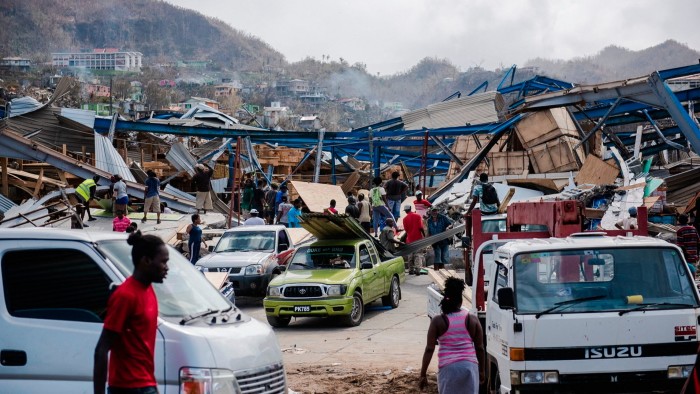A loss and damage fund, more than 30 years after developing nations first broached the idea, is finally up and running with about $700mn in initial finance, an executive director in place, and an HQ in Manila.
The scheme, which countries agreed to establish at COP27 in Sharm el-Sheikh two years ago, is intended to act as a third pillar — along with mitigation and adaptation — in the response to climate change, say experts.
The idea, explains Ibrahima Cheikh Diong, the Senegalese American appointed in September as the fund’s first executive director, is to create a vehicle for “global solidarity”, in which wealthier countries that have benefited from burning fossil fuels can help those now suffering from the consequences.
In a statement following his appointment, Diong called it “a pivotal time when the climate crisis is proving to be an existential threat to lives and livelihoods, particularly of the most vulnerable communities in developing countries”. The fund, he said, would “make a significant difference to those disproportionately affected”.
By global diplomacy standards, the momentum since the initial agreement at Sharm el-Sheikh in November 2022 has been impressive.
But the nations that are most desperately in need of help to fight the impact of climate change, including small island nations and some of the world’s most fragile states, fear they may wait years before assistance arrives.
“It’s a black box,” says Hodan Osman, president of the Development and Reconstruction Bank of Somalia, adding that countries like hers, perceived as high-risk, too often find themselves at the back of the queue when it comes to climate financing.
“When are we going to get this money?” she asks. “It’s not flowing through in the way that it should.”
Initial pledges to the fund from France, Italy, Germany, and the United Arab Emirates, plus smaller amounts from the US and Japan, will be put in trust at the World Bank, under an interim arrangement.
The first grants are expected to be made, at the very earliest, in 2025, according to the Heinrich Böll Foundation, a think-tank based in Germany.
But Osman says Somalia, which has been wracked by conflict for 30 years and severe drought for at least four, has struggled to access even the climate financing that is already available.
She estimates that her Horn of Africa country receives about $300mn in climate-related funding each year, 0.6 per cent of what Mogadishu estimated it needs. By contrast, between 2011 and 2023, Somalia received an average of $1.1bn annually in humanitarian aid, she notes.
That is bad policy and bad economics, she says, adding that money spent upfront is deployed far more effectively than funds distributed in an emergency. “Way more humanitarian aid is spent than on prevention measures, even though it’s 10 times more expensive,” she says.
Ritu Bharadwaj, principal researcher at the International Institute for Environment and Development, an independent research body, says that establishing the fund constitutes a “moral victory”. However, she believes it lacks both adequate resources and the mechanisms necessary to ensure that finance goes to those that really need it.
“The needs for dealing with loss and damage run into trillions, but the fund is in millions,” she observes. “There’s a lot of zeros missing there.”
Experts say climate finance tends to go to countries perceived as lower risk, or those with big populations, such as China, India and Indonesia. But this often leaves nothing for countries that need it most, many of which have small populations and weak institutions.
For example, when the category 5 Hurricane Maria struck the eastern Caribbean island of Dominica, in 2017, it wiped out the equivalent of 226 per cent of the country’s GDP, according to the International Recovery Platform, a UN-led global partnership.
Unlike larger islands, such as Cuba or Jamaica, Dominica — which has a population of 73,000 — can have a huge proportion of its infrastructure destroyed by such an event. The hurricane damaged the roofs of 98 per cent of the island’s buildings.
“Some island nations will face complete annihilation in the next 10 years,” warns Bharadwaj at the IEED. “That’s no exaggeration.”
Conditions can be worse for fragile states locked into cycles of poverty, hunger and violence, she adds. Her recommendation is that 40 per cent of the loss and damage fund go to such nations.
“Right now, Spain has been hit by a disaster, and people are angry and throwing mud at the king and queen,” Bharadwaj notes, referring to recent flash floods in the Valencia region, which killed more than 200 people. “But, in fragile states, when people are hit by disaster, no help arrives whatsoever. Social protection is nil.”
While wealthier nations such as Spain and Germany are likely to build back better, fragile states often fail to do so at all, she says, leaving them even more vulnerable next time round. “Climate change is contributing to more conflict and more radicalisation.”
But advocates of loss and damage funding argue that, in the end, rich and poor countries are in it together. They also note that flows of migrants to Europe and the US are being exacerbated by slow-onset climate events, such as rising sea levels, heatwaves, drought, desertification and salination of the soil.
Mahamoud Ali Youssouf, foreign minister of Djibouti, also in the Horn of Africa, says he welcomes the idea of a loss and damage fund with a mission to head off cycles of climate-induced poverty and violence.
“If you do not deal with the causes of migration — and one of them is climate change — then you will keep receiving thousands of youth looking for an opportunity,” he warns. Failing to deal with the root causes of such mass migration, he adds, is a false economy.
Read the full article here

